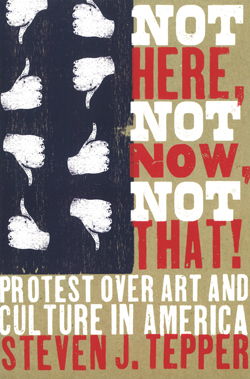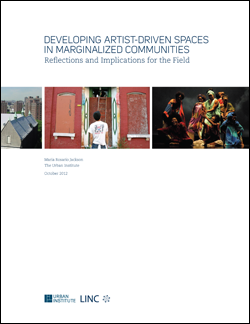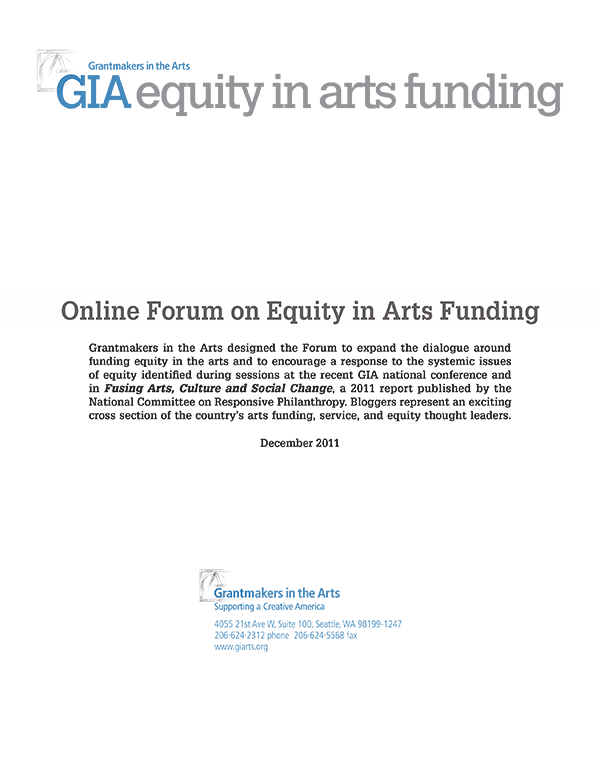Racial Equity
Grantmakers in the Arts (GIA) is committed to addressing structural inequities and increasing philanthropic and government support for BIPOC artists and arts organizations. Racial equity is a lens through which GIA aims to conduct all of its work, as well as a specific area of its programming.
Since 2008, GIA has been elevating racial equity as a critical issue affecting the field. To actualize this work within the sector, GIA published its Racial Equity in Arts Funding Statement of Purpose in 2015. Through webinars, articles, convenings, and conference sessions, GIA provides training and information to support arts funders in addressing historic and structural inequity through their grantmaking practices as part of an effort for racial justice as a means toward justice for all.
GIA believes that all oppressed groups should benefit from funding. We give primacy to race because racism is the means by which oppressed groups are manipulated into opposing programs that assist them. Therefore, Grantmakers in the Arts’ equity work – including our discussions of support for trans artists, artists with disabilities and for disability arts – is NOT race-exclusive but IS race-explicit. GIA’s vision for the future of our work is to increasingly reveal how the liberation of all oppressed people is interdependent.
GIA has made a strategic decision to foreground racial equity in our work for several reasons:
- Within other oppressed peoples’ communities (including women, members of the lgbtqi community, people with disabilities, and others), it has been well-documented that people of color still face the worst social outcomes.
- GIA feels that others’ strategies of combining considerations of race with other considerations too often result in racialized people being pushed into the background or ignored.
- The U.S.’ creation of race was established to keep oppressed peoples separate.
Unless we articulate our support for racialized peoples, while calling out this separation strategy, we inadvertently reinforce this separation strategy.
Specific themes of our racial equity programming include:
- The analysis of how funding practices create structural challenges for BIPOC (Black, Indigenous, People of Color)/ALAANA (African, Latinx, Asian, Arab, Native-American) organizations (Eurocentric quality standards, matching requirements, among others).
- The impact of these practices, as manifest in racialized disparities in levels of funding.
- An exploration of the use of coded language to justify racial inequity (i.e. referring to white audiences as “general” or “mainstream,” while organizations of color are “culturally-specific.”
When it comes to self-identifying language, GIA seeks to use terms that communicate our respect. We do not seek to impose language on members of any group. We respect the manner in which anyone prefers to self-identify. When referring to issues of racial equity, “we use the term BIPOC to highlight the unique relationship to whiteness that Indigenous and Black people have, which shapes the experiences of and relationship to white supremacy for all people of color within a U.S. context.” We take this explanation and practice from the BIPOC Project.
GIA has also used the racial and ethnic identifiers African, Latinx, Asian, Arab, and Native American. We have used African, Latinx, Asian, Arab, Native American – represented using the acronym ALAANA – because we know that many believe the term, “people of color,” conflates together entire groups of people and as a contrast to white. This results in a continued centering of whiteness as the norm and the standard from which other identities deviate.
GIA does not refer to organizations that are founded by, led by, and feature the work of ALAANA/BIPOC communities as “culturally-specific,” as we believe this term centers whiteness as the norm from which other organizations deviate.
GIA is committed to communicating respectfully. GIA does not ask that anyone self-identify with or use any term other than ones they prefer.
A new level of debate about equity began when the National Committee on Responsive Philanthropy (NCRP) released its report Fusing Arts, Culture and Social Change: High Impact Strategies for Philanthropy, by Holly Sidford, at the October 2011 GIA conference in San Francisco.
Read More...Download:
![]() Developing Artist-Driven Spaces in Marginalized Communities (3.9 Mb)
Developing Artist-Driven Spaces in Marginalized Communities (3.9 Mb)
Since the Ford Foundation’s institutional stabilization programs of the 1960s, arts funders have explored and implemented initiatives intended to promote the sustainability of arts organizations. Funding approaches, programs, and special terminology have been developed in support of the arts’ economic and social contributions to society. Artists and arts organizations are evaluated on the basis of their fiscal prudence and community contributions as well as artistic merit.
Read More...
This original work of theater, commissioned by Grantmakers in the Arts for the 58th Council on Foundations Conference, was presented at conference plenary sessions, Monday, April 30 and Tuesday, May 1, 2007. Directed by KJ Sanchez and written by KJ Sanchez, Emily Ackerman, Aysan Çelik, Darrick Clayton, Michael Place, and Amy Kim Waschke.
Read More...In 1993 my teen students and I attended a traditional music and dance camp in the remote Popoluca village of Pajapan, Veracruz, Mexico, an hour and a half from paved roads. Local homes were built from thatch.
At the foot of trees, my Chicano students, alongside their Mexican counterparts, practiced instruments and dance of the son Jarocho, a tradition created from generations of cultural encounters among Europeans, Indians and Africans. During breaks between classes the kids played soccer in an open field. At night we slept in a small dormitory visited by goats and chickens.
Read More...


